November 28, 2014
Sinai: staying safe in winter
 Winter can be an amazing time in the Sinai, especially around the town of St Katherine. This is the highest part of Egypt; the so-called High Mountain Region – The Roof of Egypt – about 1500m higher than the rest of the country. And it has the most extreme climate to boot. Snow falls most years. Sometimes, in such epic quantities it’s transformed into a realm of glistening white peaks, more like the Alps than the desert. It’s my favourite time. But it’s the most challenging time too. One that calls for a different skill set. It’s a time when you enter a world found nowhere else in Egypt, which can be deceptively dangerous. Suddenly, it’s easy to find yourself in an alien environment, where it’s hard to think the best way out of new problems.
Winter can be an amazing time in the Sinai, especially around the town of St Katherine. This is the highest part of Egypt; the so-called High Mountain Region – The Roof of Egypt – about 1500m higher than the rest of the country. And it has the most extreme climate to boot. Snow falls most years. Sometimes, in such epic quantities it’s transformed into a realm of glistening white peaks, more like the Alps than the desert. It’s my favourite time. But it’s the most challenging time too. One that calls for a different skill set. It’s a time when you enter a world found nowhere else in Egypt, which can be deceptively dangerous. Suddenly, it’s easy to find yourself in an alien environment, where it’s hard to think the best way out of new problems.
Here are ten tips to enjoying a safe winter season in the Sinai.
1. WARM, WATERPROOF CLOTHES – this seems obvious, right? Going to the mountains in winter, you’d think everyone would take warm, waterproof clothes. But it’s amazing how many people don’t. How many think that because it’s warm in Cairo or Dahab it’ll be similar – or a few degrees colder – in St Katherine. Let’s get it straight: the mountains of the Sinai are bloody cold. On top of Jebel Katherina – a quarter the height of Mount Everest at 2642m – it can drop to minus 14 degrees. And the wind can make it feel colder too. The key to staying warm is wearing multiple layers. Wear a tight, skin-hugging base layer – e.g. thermal leggings and a vest. Over that, a T-shirt, a pullover and a jacket. If they’re not warm enough, wear more layers. If they’re too hot, take some off. Pack everything in plastic bags, so it stays dry in rain. Above all, take a waterproof layer; when your clothes get wet, you lose heat five times faster. Hypothermia sets in fast. I take a good, Gore-Tex jacket and a spare plastic pocket poncho.
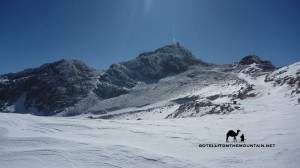 2. FOOTWEAR – it’s near-impossible to buy specialist walking boots in Egypt, let alone specialist winter boots. The next best thing are high, army style leather boots. If you’re walking in snow, it’s important to stop it going down the tops of your boots. Army boots are pretty good at this, as they strap tight around your legs, higher up than other boots. Gaiters are another option: these are basically ankle covers you strap around the tops of your boots. If you don’t have them, you can improvise with plastic bags and duck tape. That’s exactly what I did last winter, in deep snow on Jebel Katherina.
2. FOOTWEAR – it’s near-impossible to buy specialist walking boots in Egypt, let alone specialist winter boots. The next best thing are high, army style leather boots. If you’re walking in snow, it’s important to stop it going down the tops of your boots. Army boots are pretty good at this, as they strap tight around your legs, higher up than other boots. Gaiters are another option: these are basically ankle covers you strap around the tops of your boots. If you don’t have them, you can improvise with plastic bags and duck tape. That’s exactly what I did last winter, in deep snow on Jebel Katherina.
3. ESSENTIAL KIT – You need extra stuff, and a bigger pack in winter. Along with spare clothes, carry a whistle. You can blow this to attract help. A torch can be useful too. I’ve experimented with laser pens – like the ones in Midan Tahrir – and they’re great. Never go to the mountains without a mobile phone. Reception is patchy; sometimes non-existent, even on high peaks like Jebel Katherina. But there are still places with a signal. I take a small, basic Nokia phone – not a smart phone – as they’re tougher, with a better battery life. Always take matches/ a few lighters. Even in the snow, there’s dry wood in caves, under boulders etc. Take a survival bag too: this is a tough, plastic bag, about the size of a sleeping bag. A shield between you and the wind, rain and snow. Waterproofs sometimes leak. They get ripped etc. Survival bags give that last-ditch security. If you can’t find one, buy a strip of lightweight plastic sheeting. If you’re camping, you need a winter sleeping bag and a tent: otherwise, stay in gardens, with stone huts.
4. EAT WELL – You burn a lot of energy in winter, just to stay warm. Take plenty of high energy food – chocolate, sweets, halawa etc – so you can keep yourself properly heated. A thermos flask with a hot drink can be a good idea too.
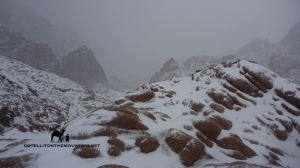 5. WEATHER – Egypt doesn’t generate specialist mountain forecasts like many Western countries, where hiking is common. Nation-wide TV forecasts give a general idea of how it’ll be. Check out YR too: it uses weather data from the St Katherine airport, a few kilos outside town (this weather station is around 1000m lower than the highest tops of the nearby mountains – so remember the weather you will experience higher will be significantly more severe). Don’t just rely on forecasts though. Watch the weather; the sky; the clouds. The weather – despite what some say – does not change in the click of a finger. It gives warning signs. It can change fast, but rarely so fast you won’t have time to find shelter, an escape route, a safer place etc. If it looks threatening, don’t hang about. Make a plan. The fastest I have seen the weather turn in the Sinai is about 40 minutes: from clear skies, to thickening clouds, to snow. See a video I took of a Sinai snowstorm last winter HERE.
5. WEATHER – Egypt doesn’t generate specialist mountain forecasts like many Western countries, where hiking is common. Nation-wide TV forecasts give a general idea of how it’ll be. Check out YR too: it uses weather data from the St Katherine airport, a few kilos outside town (this weather station is around 1000m lower than the highest tops of the nearby mountains – so remember the weather you will experience higher will be significantly more severe). Don’t just rely on forecasts though. Watch the weather; the sky; the clouds. The weather – despite what some say – does not change in the click of a finger. It gives warning signs. It can change fast, but rarely so fast you won’t have time to find shelter, an escape route, a safer place etc. If it looks threatening, don’t hang about. Make a plan. The fastest I have seen the weather turn in the Sinai is about 40 minutes: from clear skies, to thickening clouds, to snow. See a video I took of a Sinai snowstorm last winter HERE.
6. USE A BEDOUIN GUIDE – Use a good, experienced Bedouin guide. I’ve heard it said that ALL Bedouin know the mountains. Without a doubt, the Bedouin know the Sinai better than anybody in the world. But not all of them; there are still Bedouin who’ve grown up in towns, and who know virtually nothing beyond Jebel Musa. In winter, that’s not good enough. You need a guide you can trust. One who knows the way, day or night. Who knows the escape routes. The nearest shelters. One who watches the weather, who sees the subtle, early warning signs. One who’ll stay with you, however tough it gets. You can get guides from two official organisers in St Katherine: Sheikh Musa and Faraj Mahmoud. Sheikh Musa operates a rotation system. I don’t like it because I never know who I’m going to get. I get my guides from Faraj Mahmoud: in my opinion, his guides are the best available in the mountains. Call him on 0109-473-2417.
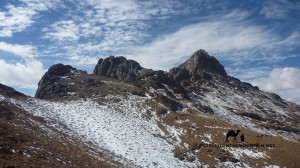 7. KNOW YOUR LIMITS – Stay well within the limits of your mountain experience in winter. And the experience of people in your group. Never do something the weakest member isn’t comfortable with. Be flexible and never be afraid to turn back from a mountain. I’ve climbed a lot of mountains in the Sinai and I’ve turned back from plenty too. It can feel hard at times – like a failure – but that’s only a short term feeling. Think about a mountain as a long term project. It’s not going anywhere; you can come back and do it again.
7. KNOW YOUR LIMITS – Stay well within the limits of your mountain experience in winter. And the experience of people in your group. Never do something the weakest member isn’t comfortable with. Be flexible and never be afraid to turn back from a mountain. I’ve climbed a lot of mountains in the Sinai and I’ve turned back from plenty too. It can feel hard at times – like a failure – but that’s only a short term feeling. Think about a mountain as a long term project. It’s not going anywhere; you can come back and do it again.
8. WHAT’S YOUR PLAN? – In winter, always – always – have a proper plan. Know the exact route – from one wadi to the next- and the schedule you will do it on. Plan escape routes. Or easier alternatives, if you need them. Know places you can shelter, like gardens or caves. It’s not enough for your guide to know this alone: you need to know it too. And you must tell someone reliable in addition, like the owner of the Bedouin camp who organises your hike. If you don’t come back on schedule, they can help start a search on your planned route, ASAP.
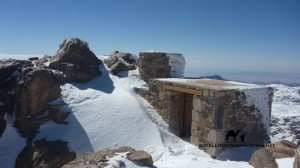 9. ALL FOR ONE, ONE FOR ALL – Always look out for your companions. When something happens to one of us in a group, it happens to all of us. Look out for your guide as well: things happen to them too. Do the same with the other folks you meet: stop, chat and keep a mental note as – in an emergency – you might be the last sources of intelligence about them. And they might be the last source of intelligence about you. And please – PLEASE, PLEASE – always leave shelters in a good condition, for the next folks. When I climbed Jebel Katherina after the snow last winter, I was the first on top: and the last person had left the window wide open, so it was full of snow. And totally useless for sleeping. Please also leave dry wood in shelters plus matches, candles and any food you can spare.
9. ALL FOR ONE, ONE FOR ALL – Always look out for your companions. When something happens to one of us in a group, it happens to all of us. Look out for your guide as well: things happen to them too. Do the same with the other folks you meet: stop, chat and keep a mental note as – in an emergency – you might be the last sources of intelligence about them. And they might be the last source of intelligence about you. And please – PLEASE, PLEASE – always leave shelters in a good condition, for the next folks. When I climbed Jebel Katherina after the snow last winter, I was the first on top: and the last person had left the window wide open, so it was full of snow. And totally useless for sleeping. Please also leave dry wood in shelters plus matches, candles and any food you can spare.
10. ACCEPT THE RISKS – Mountains are hazardous, especially in winter. The Sinai has no specialist, trained mountain rescue team, ready to go in an emergency. When you go to the mountains in winter, you HAVE to accept that. We go to the mountains for fun. Rescuers come for something else. They put their own lives in danger to try and save ours. Always remember: before it is anybody’s responsibility to rescue you; it is YOUR responsibility to go prepared.
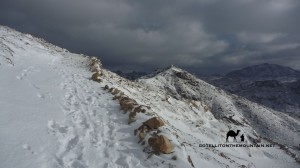 I KNOW PREPARING FOR HIKING IN EGYPT ISN’T EASY – LET ALONE WINTER HIKING. I’VE TRIED TO TALK ABOUT GEAR THAT IS READILY AVAILABLE IN EGYPT IN THIS POST. TRY ALFA MARKET IN ZAMALEK AND THE CARREFOUR IN MAADI. IF YOU NEED ANY MORE ADVICE ON HOW TO IMPROVISE WITH OTHER GEAR, CONTACT ME. AND PLEASE SHARE THIS BLOG POST TO HELP US SPREAD THE WORD ABOUT STAYING SAFE THIS WINTER!
I KNOW PREPARING FOR HIKING IN EGYPT ISN’T EASY – LET ALONE WINTER HIKING. I’VE TRIED TO TALK ABOUT GEAR THAT IS READILY AVAILABLE IN EGYPT IN THIS POST. TRY ALFA MARKET IN ZAMALEK AND THE CARREFOUR IN MAADI. IF YOU NEED ANY MORE ADVICE ON HOW TO IMPROVISE WITH OTHER GEAR, CONTACT ME. AND PLEASE SHARE THIS BLOG POST TO HELP US SPREAD THE WORD ABOUT STAYING SAFE THIS WINTER!